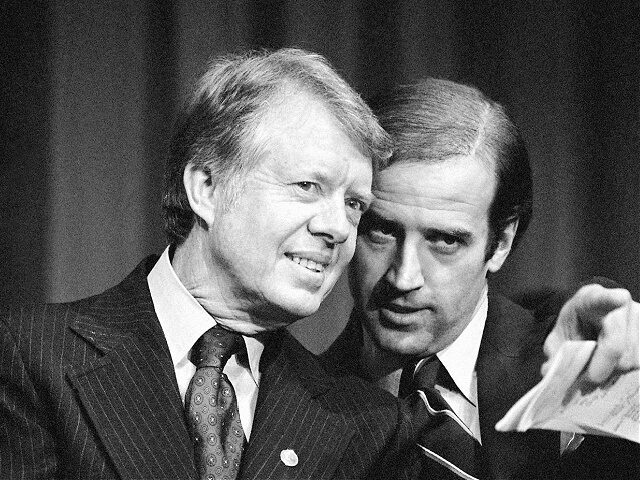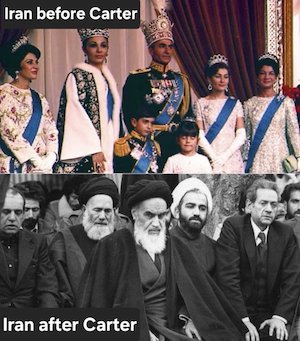As the country is swamped with hagiographies and eulogies on the main stream media, let’s look back at the one-time president who was so inept he set the scene for a grateful nation to welcome Ronald Regan to the White House in a landslide.
Jimmy Carter served as the 39th President of the United States from January 20, 1977, to January 20, 1981. His presidency was marked by significant challenges including economic stagnation, energy crises, and catastrophic foreign policy issues.
A time for reflection

Economic Struggles:
Stagflation: Carter’s presidency was marked by high inflation, high unemployment, and slow economic growth, a combination known as stagflation. His economic policies were seen by some as inadequate in dealing with these issues.
I remember taking each entire Saturday to sit in gas lines with my dad. But you could only fill half a tank. And only if your license plate ended with an odd number.
— Mila Joy (@MilaLovesJoe) December 30, 2024
And this was an entirely Carter manufactured crisis.
America has always had plenty of gas. pic.twitter.com/aaVLcRhzFg
Energy Crisis: The oil crisis of 1979 led to long gas lines, price controls, and an energy policy that many felt was too slow or ineffective in response to the crisis.
Foreign Policy:
Iranian Hostage Crisis: Perhaps the most damaging event was the 444-day ordeal where 52 American diplomats and citizens were held hostage in Iran. The failed rescue attempt, Operation Eagle Claw, was a significant embarrassment for Carter’s administration.

He just died so we're supposed to pretend he's a saint, but Carter was instrumental in killing the free, prosperous state of Rhodesia and aiding Mugabe in his takeover of it, then transforming it into hellish Zimbabwe
— Will Tanner (@Will_Tanner_1) December 30, 2024
In fact, after Harold Wilson, Carter's the key villainpic.twitter.com/s3YS3BdBVx
Soviet Invasion of Afghanistan: In response to the Soviet invasion of Afghanistan in 1979, Carter implemented several diplomatic and military measures. He imposed a grain embargo on the Soviet Union to economically pressure them and led a boycott of the 1980 Moscow Olympics as a political statement. On the military front, Carter increased defense spending, articulated the Carter Doctrine, which committed the U.S. to protect Persian Gulf oil supplies, and began covertly aiding the Afghan Mujahideen through Pakistan. These actions were aimed at countering Soviet aggression without engaging in direct military conflict. His decision to boycott the 1980 Moscow Olympics was seen by many as more symbolic than substantive.
Domestic Policy:
Deregulation: While Carter did push for deregulation in some sectors like airlines and trucking, which had long-term benefits, the immediate effects were tumultuous and contributed to economic instability.
Malaise Speech: Carter’s speech where he discussed a national “crisis of confidence” was perceived by some as him blaming the American people for their own malaise, which didn’t resonate well with the public and led to Reagan’s comment:
“I find no national malaise. I find nothing wrong with the American people. Oh, they are frustrated, even angry at what has been done to this blessed land. But more than anything, they are sturdy and robust, as they have always been.”
Leadership Style and Public Perception:
Perceived Ineffectiveness: Carter was often seen as a micromanager, focusing on details rather than the broader vision, leading to perceptions of ineffectiveness and indecisiveness.
Public Relations: His presidency was marked by what many felt was poor communication and public relations, exacerbating the negative perception of his administration’s handling of crises.
Political Maneuvering:
Party Relations: Carter’s relationship with Congress and his own party was strained at times, which affected his legislative agenda. His outsider status in Washington politics was seen as both an asset and a liability.
While Carter’s presidency had its achievements, like the Camp David Accords and his focus on human rights in foreign policy, these criticisms highlight areas where his administration was perceived to have faltered.
My thoughts on Jimmy Carter’s legacy last night on @cnn: terrible president, soundly rejected by the American people. Even worse ex-president, whose meddling in US foreign policy & virulent anti-Israel/anti-Semitic views must not be forgotten. Undermined US interests repeatedly. pic.twitter.com/kbBupU0K7O
— Scott Jennings (@ScottJenningsKY) December 31, 2024
It’s worth noting that Carter’s post-presidency work in human rights, democracy, and peace has significantly reshaped public perception of his legacy, though these do not change the historical view of his time in office.
Hope
Love this electoral map of Reagan/Carter. Carter’s loss to Reagan delivered almost 30 years of prosperity. pic.twitter.com/diJf8n7SjU
— Scott Karren (@shkarren) December 31, 2024
